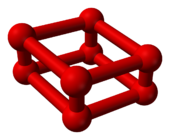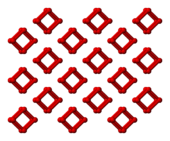Octaoxygen
 |
 |
Ball-and-stick model of O8 |
Part of the crystal structure of ε-oxygen
|
Octaoxygen, also known as ε-oxygen or red oxygen, is an allotrope of oxygen consisting of eight oxygen atoms. This allotrope forms at room temperature at pressures between 10 and 96 GPa.[1]
Preparation and properties
[edit]As the pressure of oxygen at room temperature is increased above 10 gigapascals (1,500,000 psi), it undergoes a dramatic phase transition to a different allotrope. Its volume decreases significantly,[2] and it changes color from sky-blue to deep red.[3] This ε-phase was discovered in 1979, but the structure has been unclear. Based on infrared spectroscopy, researchers assumed in 1999 that this phase consists of O
4 molecules in a crystal lattice.[4] However, in 2006, it was shown by X-ray crystallography that this stable phase is in fact O
8.[5][6] No one predicted the structure theoretically:[1] a rhomboid O
8 cluster[7] consisting of four O
2 molecules.
In this phase, it exhibits a dark-red color, very strong infrared absorption, and a magnetic collapse.[8] It is also stable over a very large pressure domain[citation needed] and has been the subject of numerous X-ray diffraction, spectroscopic and theoretical studies. It has been shown to have a monoclinic C2/m symmetry, and its infrared absorption behaviour was attributed to the association of oxygen molecules into larger units. At 11 GPa, the intra-cluster bond length of the O
8 cluster is 0.234 nm, and the inter-cluster distance is 0.266 nm, both longer than the 0.120 nm bond-length in the oxygen molecule O
2.[1]
The formation mechanism of the O
8 cluster found in the work is not clear yet, and the researchers think that the charge transfer between oxygen molecules or the magnetic moment of oxygen molecules has a significant role in the formation.[1]
Potential applications
[edit]Liquid oxygen is already used as an oxidant in rockets, and it has been speculated that octaoxygen could make an even better oxidant, because of its higher energy density.[9]
Researchers think that this structure may greatly influence the structural investigation of elements.[1]
References
[edit]- ^ a b c d e Advanced Industrial Science and Technology (AIST) (2006). "Solid Oxygen ε-Phase Crystal Structure Determined Along With The Discovery of a Red Oxygen O8 Cluster". AZoNano. Retrieved 2008-01-10.
- ^ Akahama, Yuichi; Kawamura, Haruki; Häusermann, Daniel; Hanfland, Michael; Shimomura, Osamu (June 1995). "New High-Pressure Structural Transition of Oxygen at 96 GPa Associated with Metallization in a Molecular Solid". Physical Review Letters. 74 (23): 4690–4694. Bibcode:1995PhRvL..74.4690A. doi:10.1103/PhysRevLett.74.4690. PMID 10058574.
- ^ Nicol, Malcolm; Hirsch, K. R.; Holzapfel, Wilfried B. (December 1979). "Oxygen Phase Equilibria near 298 K". Chemical Physics Letters. 68 (1): 49–52. Bibcode:1979CPL....68...49N. doi:10.1016/0009-2614(79)80066-4.
- ^ Gorelli, Federico A.; Ulivi, Lorenzo; Santoro, Mario; Bini, Roberto (November 1999). "The ε Phase of Solid Oxygen: Evidence of an O4 Molecule Lattice". Physical Review Letters. 83 (20): 4093–4096. Bibcode:1999PhRvL..83.4093G. doi:10.1103/PhysRevLett.83.4093.
- ^ Fujihisa, Hiroshi; Akahama, Yuichi; Kawamura, Haruki; Ohishi, Yasuo; Shimomura, Osamu; Yamawaki, Hiroshi; Sakashita, Mami; Gotoh, Yoshito; Takeya, Satoshi; onda, Kazumasa H (2006-08-26). "O8 Cluster Structure of the Epsilon Phase of Solid Oxygen". Physical Review Letters. 97 (8): 085503. Bibcode:2006PhRvL..97h5503F. doi:10.1103/PhysRevLett.97.085503. PMID 17026315.
- ^ Lundegaard, Lars F.; Weck, Gunnar; McMahon, Malcolm I.; Desgreniers, Serge; Loubeyre, Paul (2006-09-14). "Observation of an O8 molecular lattice in the phase of solid oxygen". Nature. 443 (7108): 201–204. Bibcode:2006Natur.443..201L. doi:10.1038/nature05174. PMID 16971946. S2CID 4384225.
- ^ Steudel, Ralf; Wong, Ming Wah (2007). "Dark-Red O8 Molecules in Solid Oxygen: Rhomboid Clusters, Not S8-Like Rings". Angewandte Chemie International Edition. 46 (11): 1768–1771. doi:10.1002/anie.200604410. PMID 17450606.
- ^ Freiman, Yu A.; Jodl, H. J. (2004). "Solid oxygen". Physics Reports. 401 (1–4): 1–228. Bibcode:2004PhR...401....1F. doi:10.1016/j.physrep.2004.06.002.
- ^ Ball, Phillip (16 November 2001). "New form of oxygen found". Nature News. doi:10.1038/news011122-3.
